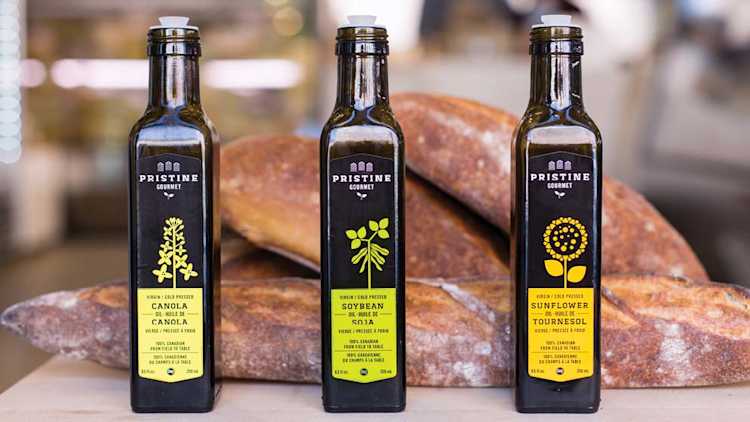Real-world lessons from farm-built brands

Beef at Tannadice Farms.
Hear from three farm operations that believe a brand is much more than a catchy name and a nice logo.
In 1974, Allen and Heather McWilliam left the hustle and bustle of Victoria, B.C., and bought a farm up-island near Courtenay. For the young couple, this was more than the beginning of a career in agriculture. It was the start of a brand journey for their business, Tannadice Farms.
As Allen McWilliam explains, it didn’t take long for the couple to see they’d created something bigger than themselves.
“We noticed the farm name was more recognizable than our family name,” McWilliam notes. “Even if people didn’t know us, when we’d talk about Tannadice Farms, their eyes lit up and they knew a lot about it.”
The name Tannadice Farms was chosen to honour the McWilliams’ shared Scottish heritage and the roots of the Angus breed they raised. Today, Tannadice Farms’ beef, pork and poultry products are found in restaurants throughout Vancouver Island and the Gulf Islands.
The brand is strongly showcased on their professionally built website and through their active Facebook presence. It’s on these media that the McWilliams connect with consumers seeking information about Tannadice products. As powerful as online media can be, Allen McWilliam believes there’s also a role for activities like farmers markets and public speaking in building a farm-based brand.
“Advertising will get you some response,” he says, “but getting in front of a group to have a conversation is so much better.”
How a brand can add value, reduce risk
For a farm with a proven production business, setting up a consumer-facing brand may seem risky. In 2000, as Jason Persall looked at options for his fourth-generation family farm, he felt the opposite.

Pristine Gourmet cold-pressed safflower, canola and soybean oils.
“There’s risk all around us,” says Persall, whose family farms near Waterford, Ont. “Some we can control and some we can’t. I wanted to take back control of some of the risks we had with our farm operation, so we looked at value-added.”
Today, Persall Fine Foods Company’s state-of-the-art cold-processing facility creates extra virgin safflower, canola and soybean oils. These products are sold under the company’s Pristine Gourmet brand.
To Persall, this value-added business has been a great way of managing commodity price risk and growing profits without buying more land and equipment.
When Pristine Gourmet failed to gain traction in the retail grocery market Persall initially targeted, he was discouraged but resolute. A chance meeting with a chef was the spark that led him to connect with restaurants and processors looking for high-quality products. That did the trick.
Pristine Gourmet represents what Persall refers to as “farm estate branding.” Their brand evokes the family’s farm heritage, the passionate makers behind the product and the distinctive taste created by the unique soil around Waterford.
“For us, the path to success was through the back door rather than direct to consumers,” Persall notes. “We never looked back once we built our brand with that focus. If you align with what the bigger companies are looking for, your road to success widens.”
Brand lays foundation for future ventures
Casey and Henrica Van Dyk began farming near Caledonia, N.S., in the mid-1950s. As they expanded the farm, they discovered wild blueberries on their property. In the 1990s, they set up a commercial wild blueberry business, supplying fresh-picked berries to local grocery stores.
The Van Dyks found, however, that selling fresh wild blueberries in a four to six-week harvest window had its limitations. To build a more sustainable business, they decided to make wild blueberry juice that could be sold all year.
In 1998, the Van Dyks hired Randy MacDonald to be their business manager. After a period of consumer research and product development, they launched Van Dyk Wild Blueberry juice, an antioxidant-rich juice made from their blueberries. Today, the juice is sold Canada-wide, with a strong international wholesale component.
For the Van Dyks, hiring professionals to create their name and look was the way to go.

Van Dyk's Wild blueberry juice
“The process wasn’t cheap, but it was money well spent,” MacDonald says. “Our design firm captured the essence of what we were trying to do. I recommend talking to several companies to make sure there’s a mutual level of comfort and understanding.”
Today, the company goes by the brand name Van Dyk’s By Nature to enable growth into new products such as dried wild blueberries and wild blueberry honey.
Sadly, the future will play out without the company’s founder, as Casey Van Dyk passed away in June 2017 at age 86. Still, the Van Dyk brand and the vision behind it will continue to guide the business.
“Casey’s cornerstone of doing business was to do it right,” MacDonald explains. “He had the idea of a healthy juice, he had the blueberries and he had an entrepreneurial spirit. He felt that if you provided the very best quality you could, consumers would acknowledge that over time.”
From an AgriSuccess article by Kieran Brett.

Three industry experts share the pros and cons to consider when thinking about incorporation.
